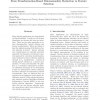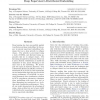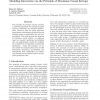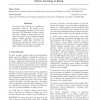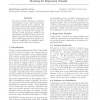ICML
2010
IEEE
14 years 18 days ago
2010
IEEE
Many learning applications are characterized by high dimensions. Usually not all of these dimensions are relevant and some are redundant. There are two main approaches to reduce d...
ICML
2010
IEEE
14 years 18 days ago
2010
IEEE
Approximate MAP inference in graphical models is an important and challenging problem for many domains including computer vision, computational biology and natural language unders...
ICML
2010
IEEE
14 years 18 days ago
2010
IEEE
Deep learning has been successfully applied to perform non-linear embedding. In this paper, we present supervised embedding techniques that use a deep network to collapse classes....
ICML
2010
IEEE
14 years 18 days ago
2010
IEEE
The principle of maximum entropy provides a powerful framework for statistical models of joint, conditional, and marginal distributions. However, there are many important distribu...
ICML
2010
IEEE
14 years 18 days ago
2010
IEEE
This paper introduces two new methods for label ranking based on a probabilistic model of ranking data, called the Plackett-Luce model. The idea of the first method is to use the ...
ICML
2010
IEEE
14 years 18 days ago
2010
IEEE
We propose a new dimensionality reduction method, the elastic embedding (EE), that optimises an intuitive, nonlinear objective function of the low-dimensional coordinates of the d...
ICML
2010
IEEE
14 years 18 days ago
2010
IEEE
When equipped with kernel functions, online learning algorithms are susceptible to the "curse of kernelization" that causes unbounded growth in the model size. To addres...
ICML
2010
IEEE
14 years 18 days ago
2010
IEEE
We study metric learning as a problem of information retrieval. We present a general metric learning algorithm, based on the structural SVM framework, to learn a metric such that ...
ICML
2010
IEEE
14 years 18 days ago
2010
IEEE
We present and derive a new stick-breaking construction of the beta process. The construction is closely related to a special case of the stick-breaking construction of the Dirich...
ICML
2010
IEEE
14 years 18 days ago
2010
IEEE
The goal of transfer learning is to improve the learning of a new target concept given knowledge of related source concept(s). We introduce the first boosting-based algorithms for...
